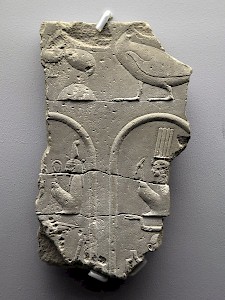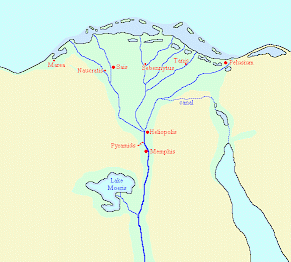Teos
Teos (Egyptian: Irmaatenra Dhejo): pharaoh of Egypt, ruled 361/360-359/358. He is also called Tachos.
Context

In the fifth century BCE, Egypt had been part of the of the Persian Empire, but it had regained its independence in 404. In 373, a large-scale attack had been repelled by pharaoh Nectanebo I, and an age of national restoration had began. To some extent, this was possible because in the second half of the 360s, the Achaemenid empire had been divided (the Satrap's revolt), and was unable to reconquer its lost territories.
Nectanebo had even made plans for an attack on the Achaemenid empire, where Phoenicia was a natural target. However, he was by now an old man, and he made his son Teos co-ruler (365). When Nectanebo died in 361/360, Teos continued the plan.
War
In the spring of 360, everything that could have been prepared, was ready. For example, there were diplomatic contacts with the rebellious satrap Orontes, a navy of 200 ships had been built, the Greek city of Athens had sent its general Chabrias, the aged Spartan king Agesilaus was present as well, and coins had been minted. The campaign was financed from the funds of the Egyptian temples, something that had caused some irritation among the priests, but was a normal thing to do. After the victory, the king would donate much gold and silver to the temples.
So Teos set out, leaving behind his brother Tjahapimu as governor of the country. However, when the expeditionary force had reached Phoenicia, news arrived that Tjahapimu had revolted and had offered the throne to his son Nectanebo II, who was in the army of Teos as commander of the Egyptian soldiers that were besieging Syrian towns. The obvious cause of the insurrection was, of course, the discontent of the priests, but one may suspect that in fact the Persian king Artaxerxes II Mnemon offered money to Tjahapimu and Nectanebo. The Persian policy to divide opponents is well-known from Greece.
The end

This marked the beginning of the end of the Persian expedition. Chabrias and the navy remained faithful to their king, but Agesilaus sided with Nectanebo. When Athens recalled Chabrias (late summer), Teos was left without support, and fled to Sidon and the Persian court, where king Artaxerxes granted him refuge. After all, he was still planning the reconquest of Egypt, and a former king might come in handy.
However, Artaxerxes died in the spring of 358, and the next Persian offensive would take place in 351. By then, Teos was probably dead.